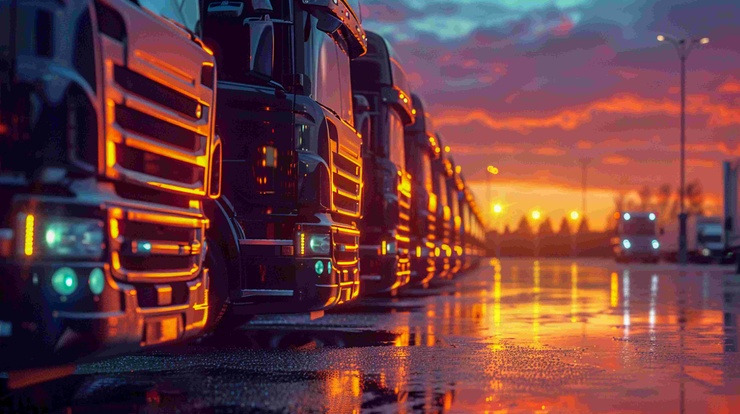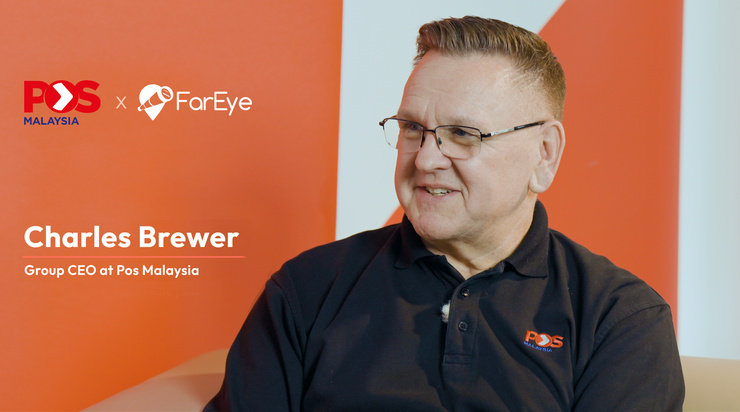- Last-Mile
How Last Mile Delivery Apps Put Control Back in Your Hands
Table of Contents
- What Makes a Last Mile Delivery App Essential?
- Taking Charge of the Last Mile and Why Control Matters More Than Ever
- Modern Last Mile Delivery App vs. Legacy Tools: Key Performance Metrics
- Features That Put You in Command of Every Delivery
- Smarter Decision-making with Powerful App Tools
- How to Choose the Right App for Complete Last Mile Control?
- Business Results When You’re in the Driver’s Seat
- Unlocking True Control Via a Last Mile Delivery App
- FAQ

For businesses managing large delivery networks, the last mile remains a critical and complex stage of the process. With the last mile delivery market forecast to grow by USD 51.1 billion by 2029, competition and customer expectations are only increasing. Dispatchers and logistics managers face increasing pressure to deliver on time, keep costs under control, and maintain clear visibility from depot to doorstep.
Each failed delivery or delayed update can quickly escalate into additional costs, customer complaints, and strained operations. Manual coordination and legacy tools struggle to keep up when order volumes increase, and service windows become tighter. A modern last mile delivery app addresses these challenges by providing businesses with the visibility and flexibility they previously lacked.
Moreover, its real-time tracking controls let dispatchers optimize routes, coordinate teams, and raise customer satisfaction. Let us look at how last mile delivery apps are reshaping the last mile and providing businesses with new ways to stay ahead of the competition.
What Makes a Last Mile Delivery App Essential?
A strong last mile delivery app links planners, drivers, and customers through one live data feed. It replaces paper manifests and phone calls with Global Positioning System (GPS) pings, photo proof of delivery, and instant status alerts. As a result, dispatchers stay informed, customers feel reassured, and finance teams see exactly which jobs were completed.
Demand spikes and road incidents can disrupt fixed plans, yet a true last mile optimization ppp adapts in seconds. It dynamically reshuffles stops and sends fresh Estimated Time of Arrival (ETA) messages to every stakeholder.
The same platform syncs with Order Management Systems (OMS), Transportation Management Systems (TMS), and other Application Programming Interfaces (API). Therefore, integration silos are eliminated.
Modern last mile delivery apps also protect data quality. They verify addresses at scan time, flag anomalies before departure, and work offline to ensure drivers remain productive in low-signal zones. Together, these features reduce idle miles and support calls, while addressing chronic issues such as poor data quality, low driver adoption, and isolated systems.
Taking Charge of the Last Mile and Why Control Matters More Than Ever
Digital commerce is climbing, urban congestion is persisting, and sustainability targets are becoming increasingly stringent each quarter. Without instant visibility, dispatchers cannot react quickly when traffic stalls or weather conditions change. A single last mile delivery app that connects depot, driver, and customer lets teams steer through this complexity rather than surrender to it.
- The Challenge of Meeting Modern Customer Demands
Buyers expect next-day arrival, narrow delivery windows, and green delivery options. Manual spreadsheets and fixed routes cannot satisfy that mix. With no last mile optimization app to refresh ETAs, drivers can stall in congestion while recipients wait without information, eroding trust and loyalty.
- The Hidden Costs of Losing Delivery Control
Each missed promise sparks overtime, second attempts, and "Where is my order?" queries. Fuel consumption increases while service desks become overloaded. A unified last mile delivery app surfaces every scan and geofence ping in real-time, allowing managers to intervene before small slips become costly failures. It also automates invoice matching, preventing silent margin loss from mis-billed carrier runs.
Modern Last Mile Delivery App vs. Legacy Tools: Key Performance Metrics
A well‑designed last mile delivery app replaces fragmented, manual workflows with connected, real‑time execution. The comparison below highlights how software‑driven operations outperform spreadsheets and phone calls across critical service and cost indicators.
| Metric | Legacy Tools | Modern Last Mile Delivery App |
| Dispatch Cycle Time | Lengthy manual setup | Rapid auto‑assignment |
| ETA Accuracy | Broad time ranges | Precise live updates |
| First‑attempt Success | Frequent reattempts | Consistently high |
| Support Calls | Heavy inbound volume | Substantially reduced |
| Cost per Stop | Elevated through empty miles and overtime | Lean through dynamic routing |
Features That Put You in Command of Every Delivery
A modern platform does more than show dots on a map; it links planning, execution, and feedback in one continuous loop. By weaving those threads together, leading last mile delivery apps replace disjointed spreadsheets with a single source of truth that anyone can act on.
- Full Visibility for Managers, Drivers, and Customers
Dispatchers monitor a control tower that highlights dwell spikes and route progress. Drivers follow turn-by-turn guidance on the same last mile delivery app, capturing proof of delivery with photos and signatures. Customers watch a live map, reducing uncertainty and the need for inbound calls. This shared context trims miscommunication and accelerates field decisions. - Smart Route Planning for the Best Path Forward
The route engine within a last mile optimization app simulates alternate possibilities based on traffic, vehicle size, and promised slots. It then selects the most efficient path and updates driver phones automatically. When a high-priority order arrives, the engine recalculates within seconds, avoiding mileage penalties and service breaches. - Instant Tracking and Status Updates at Your Fingertips
Push notifications, chatbots, and milestone banners refresh every few seconds. Recipients can redirect to a locker, approve a safe drop, or reschedule for the evening, all without needing to call support. Managers see identical updates inside their last mile delivery apps dashboard and can escalate issues before customers notice. - Quick Proof of Delivery and Simple Returns
A last mile delivery app captures signatures, barcodes, and parcel photos on the doorstep. If the item needs to be returned, the driver prints a label from their phone or a nearby Bluetooth printer. Automatic documentation closes the transaction loop, speeds refunds, and supplies regulators with audit-ready records.
Smarter Decision-making with Powerful App Tools
Real-time data only helps if it triggers timely action. Integrated analytics, automation, and communication ensure every insight converts to a concrete improvement.
- Dynamic Order Assignment and Load Balancing
A capable last mile optimization app evaluates live vehicle capacity, driver skills, and historical on-time rates. It then assigns new jobs to the best-suited courier, cutting empty miles and balancing workload across the fleet. High-density zones receive extra bikes or vans automatically, protecting punctuality during spikes. - In-app Communication for Fast Issue Resolution
Gate codes, elevator delays, and address errors no longer stall drivers. Chat, voice notes, and quick-reply templates inside the last mile delivery app connect field staff, dispatchers, and customers instantly. Problems are resolved in minutes instead of through phone tag, which wastes both labor and goodwill. - Analytics That Reveal Performance and Trends
Heat maps expose drop clusters, idle patches, and frequent reroute corridors. KPI boards display stops per hour, first-attempt delivery success rates, and carbon emissions per order. Using these insights from last mile delivery apps, planners adjust territories, tweak driver rosters, and launch eco-slot incentives before bottlenecks grow. - Secure and Scalable Platforms That Grow with Your Business
A cloud-native last mile delivery app handles data encryption, regional privacy regulations, and single sign-on out of the box. Horizontal scaling means the same stack supports a single depot today and two hundred tomorrow, shielding growth from expensive rewrites.
How to Choose the Right App for Complete Last Mile Control?
Technology should fit today’s workflows while paving the way for tomorrow’s innovations, from parcel lockers to autonomous vans.
- Seamless Integration and Scalability
Look for open APIs that integrate with order management, warehouse, billing, and customer service platforms. During seasonal peaks, your last mile delivery app should be able to ingest double the orders without requiring new hardware or manual batch scripts.
- User-friendly Design and Reliable Support
Drivers need an intuitive interface that works offline in dense basements or remote suburbs. Dispatchers want drag-and-drop stops and color-coded alerts. Select a last mile optimization app with multi-language menus, embedded tutorials, and proactive help desks so every role onboards fast.
- Measuring ROI to Ensure Real Control and Value
Deploy baseline dashboards on first-attempt success, cost per drop, Net Promoter Score, and fuel usage. Quality last mile delivery apps include built-in reporting that shows savings month by month, confirming the investment and highlighting new efficiency projects.
Business Results When You’re in the Driver’s Seat
When data flows freely and decisions are made automatically, delivery transforms from a liability to an advantage.
- Higher First-attempt Delivery Success
Shared navigation, automated customer reminders, and instant exception handling combine inside one last mile delivery app to keep drivers on time and recipients ready. That collaboration lifts first-attempt success, freeing capacity for new orders.
- Lower Costs and Smoother Operations
Smart batching in a last mile optimization app reduces deadhead miles. Automated returns shave depot labor. Combined, these efficiencies reduce total delivery orchestration expenses while smoothing daily dispatch rhythms, eliminating lunch-hour bottlenecks and late-night overtime.
- Happier Customers and Stronger Loyalty
Live maps and two-way messaging build confidence from checkout to doorstep. Transparent service drives down cart abandonment and lifts reorder rates. Companies adopting modern last mile delivery apps routinely report double-digit boosts in loyalty metrics sooner.
Unlocking True Control Via a Last Mile Delivery App
Securing complete oversight turns delivery from a cost center into a source of strategic strength. When dispatchers can reprioritize stops in seconds, drivers receive updated guidance, and customers track accurate ETAs, first-attempt success rates rise, and avoidable expenses decrease. Data flowing through a single mobile interface also reveals idle time, empty miles, and dwell spikes, allowing managers to refine processes before they erode margins.
FarEye helps enterprises operationalize this vision. Our cloud platform unifies route optimization, live tracking, driver workflows, and customer alerts within a single, configurable BPM framework. Open APIs speed integration while AI engines balance loads and predict exceptions.
FAQ
How does the app integrate with my TMS or OMS?
FarEye provides well‑documented REST and webhook APIs that connect order, inventory, and shipment data to leading Transportation Management Systems (TMS) and Order Management Systems (OMS). A pre-built middleware layer maps reference fields, such as order IDs, status codes, and location timestamps, to your existing database structure, allowing new events to flow automatically into planning and billing modules without manual re-entry. Most teams complete end‑to‑end data exchange within a standard implementation cycle.
Can drivers use the app offline?
Yes. The driver application caches route details, customer instructions, and barcode data on the device before leaving the depot. While offline, drivers can capture proof of delivery photos, signatures, and notes; the information is time‑stamped and stored locally. As soon as the device reconnects to a cellular or Wi‑Fi network, all events synchronize with the control tower and customer portals, ensuring no gaps in tracking history or KPI reports.
Sources:
https://www.technavio.com/report/last mile-delivery-market-size-industry-analysis

Komal Puri is a seasoned professional in the logistics and supply chain industry. As the AVP of Marketing and a subject matter expert at FarEye, she has been instrumental in shaping the industry narrative for the past decade. Her expertise and insights have earned her numerous awards and recognition. Komal’s writings reflect her deep understanding of the industry, offering valuable insights and thought leadership.
Let's Talk to Our Experts and Optimize Your Deliveries Today!
An expert from our team will reach out within 24 hours

